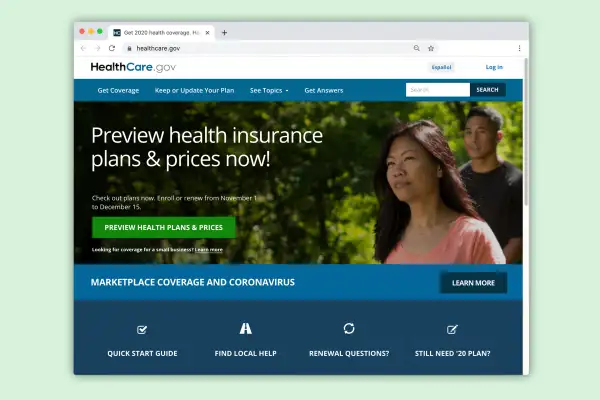Obamacare Open Enrollment Starts Today. Here's What to Know

Open enrollment begins on Sunday for the 11.4 million Americans who have individual health insurance through healthcare.gov or their state marketplace, and for new consumers who want to enroll in Obamacare for the first time.
A cloud of uncertainty hangs over open enrollment this year. On Nov. 10, the Supreme Court is set to hear oral arguments in a lawsuit that seeks to overturn the Affordable Care Act, also known as Obamacare. A ruling is expected by June, 2021. Even if the lawsuit prevails and justices vote to invalidate the law, changes to consumers' health coverage may be gradual, experts say.
"It's better to get a plan, and if something were to happen, it probably won't unwind all of a sudden," says Nathan Teater, manager of customer care at eHealthInsurance.com.
So the best advice from prior years still holds: even if you're happy with your current coverage, shop around to see if it's still the best fit for your needs. Here's what to know:
When Is Obamacare Open Enrollment for 2021?
Open enrollment runs from Nov. 1 through Dec. 15 for coverage starting Jan. 1, 2021. During this window, current customers can switch health insurance plans for next year, while new customers can buy a fresh policy. Dec. 15 is the deadline for states that use the federal healthcare.gov platform. Many of the states that run their own exchanges have extended the open enrollment deadline beyond Dec. 15, although you may still need to enroll by that date for your coverage to start on Jan. 1.
If existing customers do nothing, you’ll be automatically re-enrolled in your current plan for next year. If prospective customers do nothing, you’ll be shut out of the market for 2021 coverage unless you qualify for a special enrollment period through a change in life circumstance like having a baby, moving, or losing job-based coverage. This last criteria means the many Americans who continue to be laid off due to the coronavirus pandemic can typically buy health insurance whenever that happens, even if it's outside of open enrollment.
Where is the Health Insurance Marketplace?
Most states use the federal marketplace at healthcare.gov, and you can buy your policy directly on that site. Around 14 states and Washington, D.C. operate their own state-run enrollment websites, but you can still get to them from healthcare.gov: enter your zip code and the site will provide a link to your state’s health insurance marketplace.
Healthcare.gov isn’t the only place you can enroll in a major medical plan — you can buy one through a broker as well. But beware: outside web sites may also sell plans that are not comprehensive health insurance, such as skimpy short-term plans that are cheaper but often come with a host of exclusions for pre-existing conditions.
All of the plans on healthcare.gov and the state-run exchanges are comprehensive plans that must cover essential health benefits such as maternity care, hospitalizations, prescription medications, and any pre-existing conditions of the policyholder.
How to Get Affordable Health Insurance
The good news is that premiums on the exchanges are roughly flat this year. What's more, consumers have more choices this year since some carriers are expanding their offerings on the exchanges, Teater says. The bad news is that coverage remains too expensive for many of the roughly 10% of consumers whose incomes are too high to qualify them for government subsidies that lower their monthly premium cost. Starting in 2019, when individual mandate penalty went to $0 and people were no longer required to buy coverage or pay a penalty, many unsubsidized consumers dropped their policies.
Before you shop for policies, input your estimated income for 2021 into healthcare.gov so you can see health insurance quotes that reflect your own, individual costs, which may be different from the sticker price.
Even if you’re happy with your coverage, it’s a good idea to compare your options. For starters, your premium subsidy for next year could change — it’s based on both your income and the benchmark silver plan in your area, which can vary from year to year — so it’s important to input your projected 2021 income to get an updated estimate of what you’ll owe for your current coverage or any alternatives. If your income changes at any point during the year, visit healthcare.gov to update your profile. Otherwise, if you made more than projected, you may have to repay a portion of your premium subsidy at tax time the following year.
Lastly, if you want to keep your doctors, make sure they take any plans you’re considering. Online doctor directories might not be up to date, so the best way to do that is to call the doctor’s office and read them the full name of the plan. "They know who they get paid by," Teater says.

